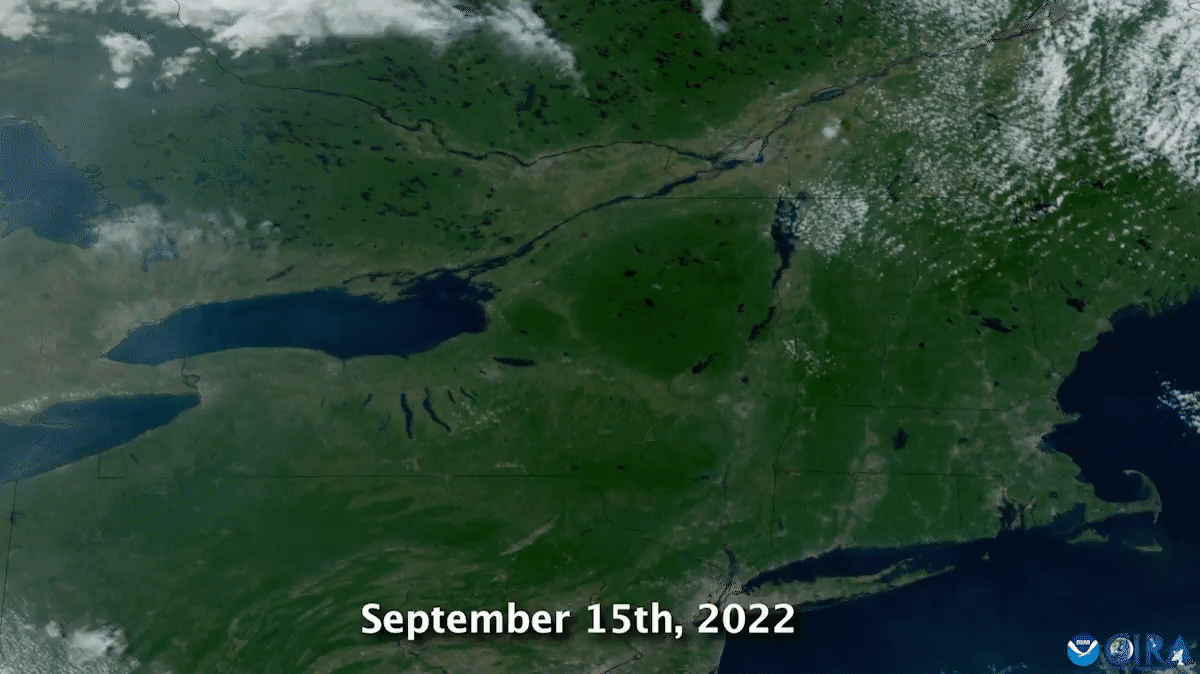Are your senses feeling hangry? Maybe all they need is a little feast of fall foliage! If you live in a place where leaves turn, I encourage you to take a stroll – ideally, many strolls – with no agenda or distractions beyond letting your eyes, ears and nose revel in the riches of the season.
That autumn leaves look, sound and smell great is all most of us need to know. Just in case you’ve ever wondered about the mechanics beneath the grandeur, though, I’ve got some tidbits of science to share.
First, check out this cool satellite image of the northeastern U.S., showing the change from mid-September to mid-October.


The quality of the leaf peeping in any given place or season depends on three things: the chemical makeup of the leaves, the health of the trees, and weather conditions.
Leaves are full of phytochemicals (chemicals produced by plants), including chlorophyll, carotenoids, anthocyanins and tannins. The particular composition of chemicals in a leaf will determine its fall coloring.
Chlorophyll gives leaves their green color. It’s in a continual cycle of production and breakdown during the growing season, but as nights lengthen in autumn, chlorophyll production slows and eventually stops. This lets the other phytochemicals step up to the mike.
Carotenoids are the source of the yellow and orange colors of many plants – think sunflowers, corn and carrots – as well as fall leaves. Carotenoids are always present in the leaves, but they lurk backstage until chlorophyll takes its bow.
Anthocyanins give color to cranberries, grapes, blueberries, cherries and plums, as well as red and purple autumn leaves. Unlike carotenoids, they’re not necessarily present in leaves year-round, but they kick into gear in the fall.
Tannins are generally responsible for the brown color of leaves when they’re mostly or completely dead. They act as a kind of natural preservative. Have you ever noticed that oak leaves keep their shape on the ground long after other leaves have turned to dust? They owe their stamina to a healthy dose of tannins.

The healthier a tree, the brighter its fall foliage. When trees are stressed, it affects the production and maintenance of those phytochemicals, causing their foliage to be off-color or dull. Sickly trees will also drop their leaves early.
The prime weather conditions for flashy foliage are bright sunlight, adequate moisture (not too little, not too much) and cool nights (crisp but not freezing). A late spring or severe summer drought can delay the onset of color by a few weeks. A warm period during the fall will lower the intensity of colors.
So here’s the formula: carotenoids + anthocyanins + healthy trees + moist soil + sunny days + crisp nights = optimal leaf peeping.
And whether or not you've got ideal conditions, you can find out when your surroundings will (or did) hit their peak for the year at the interactive Smoky Mountains National Park Fall Foliage Prediction Map. Here’s a screenshot of the prediction for today, October 17, 2022. Does it match what you’re seeing out your window?
Get out there and enjoy the leaves while they’re turning! And remember, once they’ve fallen, leave them be.
This week’s Bees’ Keys selection has nothing to do with leaves. But I heard it performed over the weekend and was reminded it’s an all-season winner:
Resources
Jim McGlone, “The Color of Trees and Fall Leaves,” Northern Virginia Soil and Water Conservation District.
Matthew Ross, then-Director of Continuing Education, Longwood Gardens, “The Science and Beauty of Fall Color,” video presentation, fall 2021.
Jerrold Samford, “The Color of Leaves: Why They Change their Clothes in the Autumn,” VPM Media Corporation, November 11, 2016.
“The Chemicals Behind the Colours of Autumn Leaves,” Compound Interest, September 11, 2014.
“Leaf Pigments,” Harvard Forest.
“Science of Fall Colors,” U.S. Forest Service website.






Your oak leaf hydrangea photo is beyond-imaginingly lovely!
Wrapping paper? Greeting card? Dish towel?
Awesome song and you KNOW I love those stage analogies! ❤️